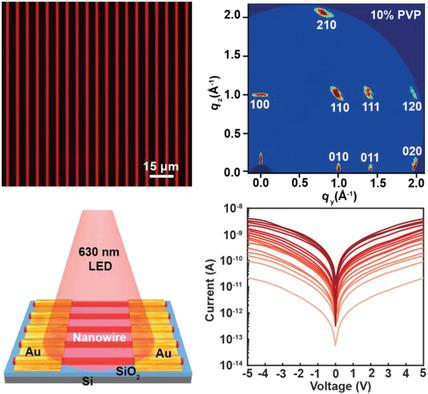当前位置:
X-MOL 学术
›
Adv. Funct. Mater.
›
论文详情
Our official English website, www.x-mol.net, welcomes your
feedback! (Note: you will need to create a separate account there.)
Stable α‐CsPbI3 Perovskite Nanowire Arrays with Preferential Crystallographic Orientation for Highly Sensitive Photodetectors
Advanced Functional Materials ( IF 18.5 ) Pub Date : 2019-02-04 , DOI: 10.1002/adfm.201808741 Gaosong Chen 1 , Jiangang Feng 2, 3 , Hanfei Gao 2, 3 , Yingjie Zhao 2, 3 , Yueyang Pi 4 , Xiangyu Jiang 2 , Yuchen Wu 2 , Lei Jiang 1, 2, 3
Advanced Functional Materials ( IF 18.5 ) Pub Date : 2019-02-04 , DOI: 10.1002/adfm.201808741 Gaosong Chen 1 , Jiangang Feng 2, 3 , Hanfei Gao 2, 3 , Yingjie Zhao 2, 3 , Yueyang Pi 4 , Xiangyu Jiang 2 , Yuchen Wu 2 , Lei Jiang 1, 2, 3
Affiliation

|
All‐inorganic metal‐halide perovskites CsPbX3 (X = Cl, Br, I) exhibit higher stability than their organic–inorganic hybrid counterparts, but the thermodynamically instable perovskite α phase at room temperature of CsPbI3 restricts the practical optoelectronic applications. Although the stabilization of α‐CsPbI3 polycrystalline thin films is extensively studied, the creation of highly crystalline micro/nanostructures of α‐CsPbI3 with large grain size and suppressed grain boundary remains challenging, which impedes the implementations of α‐CsPbI3 for lateral devices, such as photoconductor‐type photodetectors. In this work, stable α‐CsPbI3 perovskite nanowire arrays are demonstrated with large grain size, high crystallinity, regulated alignment, and position by controlling the dewetting dynamics of precursor solution on an asymmetric‐wettability topographical template. The correlation between the higher photoluminescence (PL) intensity and longer PL lifetime indicates the nanowires exhibit stable α phase and suppressed trap density. The preferential (100) orientation is characterized by discrete diffraction spots in grazing incidence wide‐angle scattering patterns, suggesting the long‐range crystallographic order of these nanowires. Based on these high‐quality nanowire arrays, highly sensitive photodetectors are realized with a responsivity of 1294 A W−1 and long‐term stability with 90% performance retention after 30‐day ambient storage.
中文翻译:

稳定的α-CsPbI3钙钛矿纳米线阵列,具有优先的晶体学取向,适用于高灵敏度的光电探测器。
全无机金属卤化物钙钛矿CsPbX 3(X = Cl,Br,I)比其有机-无机杂化钙钛矿具有更高的稳定性,但室温下CsPbI 3的热力学不稳定钙钛矿α相限制了实际的光电应用。虽然α-CsPbI的稳定3多晶薄膜被广泛地研究,高度结晶的微/α-CsPbI的纳米结构的产生3具有大晶粒尺寸和抑制晶界仍然具有挑战性,α-CsPbI的阻碍的实现3用于侧向设备,例如光电导体型光电探测器。在这项工作中,稳定的α‐CsPbI 3钙钛矿纳米线阵列通过控制前体溶液在不对称润湿性地形模板上的去湿动力学,证明具有大晶粒尺寸,高结晶度,可调节的排列和位置。较高的光致发光(PL)强度和较长的PL寿命之间的相关性表明纳米线表现出稳定的α相和抑制的陷阱密度。优先(100)取向的特征是在掠入射入射的广角散射图中存在离散的衍射点,表明这些纳米线的长程晶体学顺序。基于这些高质量的纳米线阵列,可以在30天的环境存储后,以1294 AW -1的响应度和长期稳定性以及90%的性能保留实现高灵敏度的光电探测器。
更新日期:2019-02-04
中文翻译:

稳定的α-CsPbI3钙钛矿纳米线阵列,具有优先的晶体学取向,适用于高灵敏度的光电探测器。
全无机金属卤化物钙钛矿CsPbX 3(X = Cl,Br,I)比其有机-无机杂化钙钛矿具有更高的稳定性,但室温下CsPbI 3的热力学不稳定钙钛矿α相限制了实际的光电应用。虽然α-CsPbI的稳定3多晶薄膜被广泛地研究,高度结晶的微/α-CsPbI的纳米结构的产生3具有大晶粒尺寸和抑制晶界仍然具有挑战性,α-CsPbI的阻碍的实现3用于侧向设备,例如光电导体型光电探测器。在这项工作中,稳定的α‐CsPbI 3钙钛矿纳米线阵列通过控制前体溶液在不对称润湿性地形模板上的去湿动力学,证明具有大晶粒尺寸,高结晶度,可调节的排列和位置。较高的光致发光(PL)强度和较长的PL寿命之间的相关性表明纳米线表现出稳定的α相和抑制的陷阱密度。优先(100)取向的特征是在掠入射入射的广角散射图中存在离散的衍射点,表明这些纳米线的长程晶体学顺序。基于这些高质量的纳米线阵列,可以在30天的环境存储后,以1294 AW -1的响应度和长期稳定性以及90%的性能保留实现高灵敏度的光电探测器。

































 京公网安备 11010802027423号
京公网安备 11010802027423号